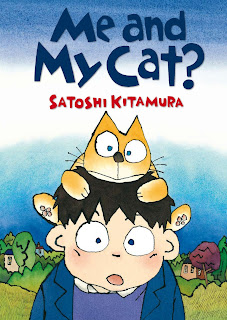General Information
Title: Me and My Cat?
Author: Satoshi Kitamura
Genre: Fiction
Publisher: Andersen Press
Date of Publication: 2009
Illustrator: Satoshi Kitamura
NOTE: This review is based on an online read-aloud of Me and My Cat? (read by Elijah Wood), which can be found here: Me and My Cat? - Storyline Online (read-aloud).
Lexile Level & Target Audience
Lexile: N/A; comparable to 3rd grade level
Age Range: 3-5
Audience: boys and girls, fans of Anime, cat owners
Brief Summary
Me and My Cat? is a humorous story about a boy who, under the spell of a witch, ends up switching bodies with his cat for a day. As the boy (i.e. Leonardo the cat) explores his neighborhood block, he meets his "cat mother," gets into a fight with some mean looking cats, and gets chased by a scary-looking dog. In the end, he returns home and gets "un-switched," only to find a surprise awaiting him at school the next day...
Evaluation: Pros & Cons
Pros:
1. A good tool for introducing students to the concept of empathy. As humorous as it is, this text shows a boy who is actually seeing from his cat's perspective, sharing in his experiences. This is not just a simple, "Oh, that's too bad," response; the boy actually understands and feels what his cat is feeling, and comes to the conclusion that "Leonardo's life was as tough and complicated as it was for humans." This is a great way for younger children to begin to understand the concept of empathizing with the people around them.
2. The book transcends stereotypes. Although this book is written by an Asian author and contains an (assumedly) Asian protagonist, it contains no stereotypical elements; in addition, the family appears to be of mixed race, as the mom appears to be Caucasian.
Cons:
1. Negative aspects of relationship with mom. The boy's mother shouts at him to wake up, concerned he'll be late for school, and "drags" him into the kitchen for breakfast. Though she is concerned about him when he's sick, we don't get a very positive view of their relationship.
2. "I didn't have to go to school." The boy makes this short quip about school when he realizes that he won't have to go since he's a cat; however, the wonder of read-alouds is that you could simply choose to leave this one line out.
Literary Elements
Reversal: The story quickly takes on a dramatic change when the protagonist suddenly finds himself inside the body of his cat, Leonardo. This change is dealt with throughout the story, and is eventually reversed again, with the boy back in his own body.
Alliteration: Kitamura uses alliteration when he writes that the witch "brandished her broom."
Mood: Kitamura gives this text a quick-moving pace by carefully structuring his sentences into short, concise phrases; there is no excess detail. In fact, there is only just enough description to keep the story moving––that is, each sentence moves the story forward through its brevity and precision.
Illustrations
Readers who enjoy anime will be fond of Kitamura's illustrations, as they have a very similar style. The illustrations also work to convey the humor of the story just as much as the text does (which is probably due in part to the fact that Kitamura both writes and illustrates the text, allowing him to craft the two together seamlessly).
Mini-lesson Idea(s)
This text would be great for helping students develop authentic personalities and narrative for the characters in their writing. For example, much like Kitamura writes about Leonardo's life as a cat (through a boy experiencing the cat's life), students could write from the perspective of an animal, a person they know, or a character they invent themselves. Students could begin these drafts by first listing out things they might experience if they themselves were in this animal/person/character's shoes. Using this information, students could develop a profile and eventually a longer piece of prose or poetry to reflect this character.
- Aubrey

No comments:
Post a Comment